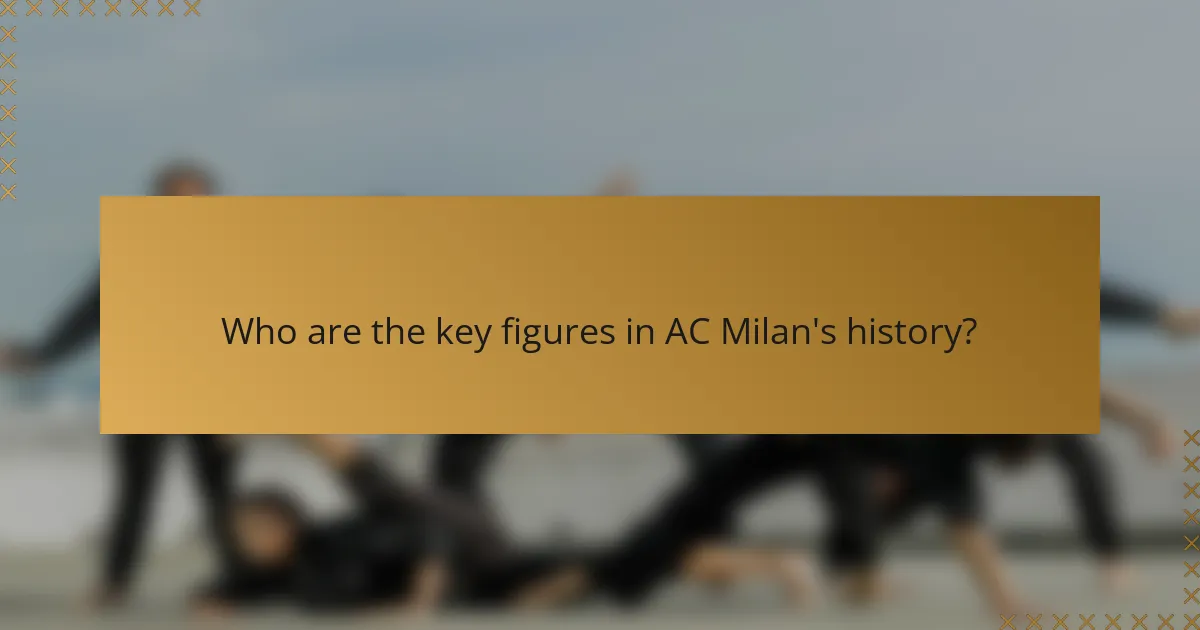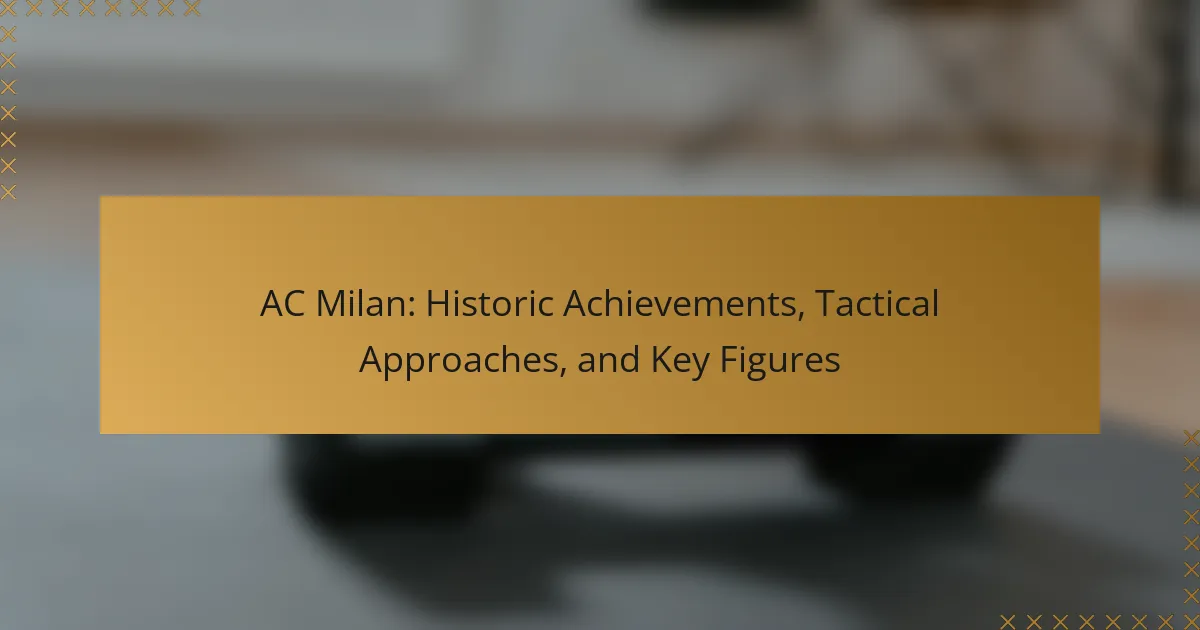AC Milan stands as a titan in football history, renowned for its impressive 18 Serie A titles and 7 UEFA Champions League trophies. The club’s legacy is shaped by tactical innovations and legendary figures like Paolo Maldini and Marco van Basten. AC Milan’s playing style emphasizes tactical discipline and versatility, while key moments highlight their resilience and excellence on the international stage. This article explores the club’s historic achievements, tactical approaches, and influential players that define its identity.

What are AC Milan’s most significant historic achievements?
AC Milan’s most significant historic achievements include winning 18 Serie A titles and 7 UEFA Champions League trophies. The club’s dominance in Italian football is marked by its tactical innovations and legendary players. Notable figures like Paolo Maldini and Franco Baresi contributed to its storied legacy. Additionally, AC Milan has enjoyed success in various domestic and international competitions, solidifying its status as a football powerhouse.
How many Serie A titles has AC Milan won?
AC Milan has won 18 Serie A titles. This achievement places them among the most successful clubs in Italian football history. Their last title came in the 2021-2022 season, showcasing their enduring competitive spirit and tactical prowess.
Which European competitions has AC Milan excelled in?
AC Milan has excelled in several European competitions, notably the UEFA Champions League and the UEFA Super Cup. The club has won the Champions League seven times, making it one of the most successful teams in the tournament’s history. Additionally, AC Milan has secured the UEFA Super Cup four times, showcasing its dominance on the European stage. The club’s rich history and tactical prowess have contributed to these achievements, solidifying its reputation as a powerhouse in European football.
What records does AC Milan hold in Italian football?
AC Milan holds numerous records in Italian football, showcasing its historic dominance. The club has won the Serie A title 18 times, making it one of the most successful teams in the league’s history. Additionally, AC Milan boasts a record of seven Coppa Italia victories and has achieved the Supercoppa Italiana title 7 times. The club is also renowned for its European success, with seven UEFA Champions League titles, a record for an Italian club. These achievements underline AC Milan’s status as a powerhouse in Italian football.
How has AC Milan’s legacy influenced global football?
AC Milan’s legacy has profoundly influenced global football through its historic achievements, tactical innovations, and iconic figures. The club’s success in domestic and international competitions, including seven UEFA Champions League titles, established a benchmark for excellence.
AC Milan’s tactical approaches, particularly under managers like Arrigo Sacchi and Carlo Ancelotti, revolutionized the game with a focus on pressing and fluid attacking play. Their strategies have been emulated worldwide, shaping modern football tactics.
Key figures such as Paolo Maldini and Franco Baresi have not only excelled on the pitch but have also inspired generations of players with their leadership and dedication. The club’s commitment to developing talent has set a standard for youth academies globally.
Overall, AC Milan’s influence extends beyond its trophies, impacting how football is played and appreciated around the world.

What tactical approaches define AC Milan’s playing style?
AC Milan’s playing style is defined by a blend of tactical discipline, fluid formations, and strategic pressing. The team emphasizes a solid defensive structure while maintaining versatility in attack. Key approaches include a strong focus on positional play, quick transitions, and exploiting width through wing play. Their tactical flexibility allows for adaptations based on opponents, often utilizing a 4-2-3-1 formation. This adaptability is a unique attribute that sets AC Milan apart in their historic achievements.
How has AC Milan’s formation evolved over the years?
AC Milan’s formation has evolved significantly, adapting to changing tactical philosophies and player capabilities. Historically, the club has transitioned from a classic 2-3-5 formation to more modern variants like 4-4-2 and 4-3-3.
In the late 1980s and early 1990s, under Arrigo Sacchi, the team adopted a pressing 4-4-2, emphasizing high defensive lines and teamwork. This approach led to multiple European titles.
Later, under Carlo Ancelotti, a flexible 4-3-2-1 formation emerged, allowing for both defensive solidity and attacking creativity. Key players like Kaká thrived in this system, showcasing the adaptability of the formation.
Recently, the team has utilized a 4-2-3-1 setup, balancing defensive resilience with offensive flair, reflecting the current tactical trends in football. This evolution highlights AC Milan’s ability to innovate while maintaining a strong competitive edge.
What are the key tactical philosophies employed by AC Milan managers?
AC Milan managers employ tactical philosophies focused on defensive solidity, fluid attacking play, and adaptability. These approaches have evolved, reflecting the club’s historic achievements and key figures.
Historically, managers like Arrigo Sacchi emphasized pressing and a high defensive line, transforming the team’s style. Fabio Capello introduced a more pragmatic approach, prioritizing results and organized defense. In recent years, managers like Stefano Pioli have combined these philosophies with modern tactics, focusing on player versatility and quick transitions.
The tactical evolution showcases a blend of traditional Italian defensive strategies with contemporary attacking principles, allowing AC Milan to remain competitive in both domestic and European competitions.
How does AC Milan’s defensive strategy compare to other top clubs?
AC Milan’s defensive strategy emphasizes organization and tactical discipline, often ranking among the best in Europe. Their approach focuses on a solid backline, effective pressing, and quick transitions. Compared to other top clubs, AC Milan’s unique attribute is their ability to integrate youth players into the defense, enhancing adaptability. While clubs like Manchester City and Bayern Munich prioritize possession, Milan’s rare attribute is their counter-attacking prowess, allowing them to capitalize on opponents’ mistakes. This combination of tactics has led to historic success in both domestic and European competitions.
Which players have been pivotal in AC Milan’s tactical setups?
Key players pivotal in AC Milan’s tactical setups include Paolo Maldini, Franco Baresi, and Andrea Pirlo. Their strategic roles shaped the team’s defensive and midfield dynamics. Maldini’s versatility and leadership established a strong defense, while Baresi’s tactical intelligence anchored the backline. Pirlo’s vision and passing transformed midfield control, enabling fluid attacking movements. Each player’s unique attributes contributed significantly to AC Milan’s tactical evolution, making them essential figures in the club’s history.

Who are the key figures in AC Milan’s history?
Key figures in AC Milan’s history include legendary players and influential coaches. Notable players are Paolo Maldini, who spent 25 years at the club, and Marco van Basten, a three-time Ballon d’Or winner. Coaches like Arrigo Sacchi, known for his tactical innovations, and Carlo Ancelotti, who led the team to multiple Champions League titles, also shaped the club’s legacy. Their contributions solidified AC Milan’s status as one of the most successful clubs in football history.
Which legendary players have shaped AC Milan’s success?
Legendary players who have shaped AC Milan’s success include Paolo Maldini, Franco Baresi, and Marco van Basten. Their contributions defined the club’s identity and achievements.
Paolo Maldini, a versatile defender, spent 25 years with the club, winning seven Champions League titles. Franco Baresi, another defensive stalwart, led the team for over a decade, securing six Champions League victories. Marco van Basten, known for his striking prowess, played a crucial role in the late 1980s and early 1990s, helping the team win three Champions League titles during his tenure.
These players exemplified exceptional skill and leadership, leaving a lasting legacy at AC Milan. Their unique attributes contributed significantly to the club’s historic achievements and tactical approaches.
What impact have notable coaches had on AC Milan’s performance?
Notable coaches have significantly influenced AC Milan’s performance through tactical innovations and leadership. Coaches like Arrigo Sacchi and Carlo Ancelotti implemented strategies that led to domestic and European success. Sacchi’s pressing game transformed team dynamics, resulting in back-to-back European Cups in the late 1980s. Ancelotti’s emphasis on flexibility and player management secured multiple titles, including the Champions League in 2003 and 2007. These coaching philosophies have shaped AC Milan’s identity and competitive edge in football.
How do current players contribute to AC Milan’s legacy?
Current players contribute to AC Milan’s legacy by embodying the club’s storied history and striving for excellence. Their performances on the pitch reflect the tactical philosophies established by past legends. Key figures like Zlatan Ibrahimović and Rafael Leão not only bring skill but also leadership, inspiring younger teammates. The team’s commitment to winning and maintaining high standards reinforces AC Milan’s reputation as a powerhouse in football. Through their dedication, they ensure the legacy continues, blending tradition with modern success.

What unique attributes set AC Milan apart from other clubs?
AC Milan is distinguished by its rich history, iconic players, and tactical innovations. Unique attributes include a record number of European Cup titles, a strong youth academy, and a distinctive playing style that emphasizes technical skill and teamwork. The club’s legacy is further enhanced by legendary figures like Paolo Maldini and Franco Baresi, who have shaped its identity. Additionally, AC Milan’s passionate fanbase and global brand presence contribute to its unique status in football.
How does AC Milan’s fan culture influence the club’s identity?
AC Milan’s fan culture profoundly shapes the club’s identity through deep-rooted traditions and passionate support. The club’s history is intertwined with its supporters, who contribute to a vibrant atmosphere during matches. This connection fosters loyalty and pride, enhancing the team’s reputation both locally and globally. The unique attribute of AC Milan’s fan culture is its blend of historical reverence and modern engagement, which distinguishes it from other clubs. As a result, the fans’ unwavering dedication reinforces the club’s legacy and competitive spirit.
What are the distinctive features of AC Milan’s branding and merchandise?
AC Milan’s branding and merchandise feature a rich history, iconic colors, and a strong emotional connection with fans. The club’s red and black colors symbolize passion and strength. Merchandise includes jerseys, training gear, and accessories that reflect the club’s identity. Unique features include collaborations with high-end brands and limited-edition items that celebrate historic achievements. The club’s logo, representing its heritage, is a key attribute that enhances brand recognition globally.

What are some rare moments that define AC Milan’s journey?
AC Milan’s journey is defined by rare moments that showcase their resilience and excellence. One significant event occurred in 2007 when they won the UEFA Champions League, defeating Liverpool in the final, a redemption after their 2005 loss. Another rare moment was the 1994 Champions League final, where they triumphed over Barcelona 4-0, showcasing a tactical masterclass. The 1963 European Cup victory against Benfica marked their first European title, establishing AC Milan as a dominant force. Lastly, the 1989-1990 season, where they won back-to-back European Cups, exemplified their tactical innovation under Arrigo Sacchi.
Which unexpected victories stand out in AC Milan’s history?
AC Milan’s unexpected victories include the 2003 UEFA Champions League final against Juventus, where they triumphed in a penalty shootout, and the 2007 Champions League final against Liverpool, avenging their 2005 defeat. Another notable win was the 1994 UEFA Champions League final against Barcelona, where they secured a stunning 4-0 victory. These matches highlight AC Milan’s resilience and tactical prowess, showcasing their ability to perform under pressure.
What are the lesser-known challenges AC Milan has faced?
AC Milan has faced challenges such as financial instability, management changes, and injuries to key players. These issues have impacted their performance and consistency over the years. Financial difficulties arose particularly after the club’s transition in ownership, affecting their ability to compete in the transfer market. Frequent changes in management have led to instability in tactics and player development. Additionally, injuries to star players have hindered their competitive edge in crucial matches.

How can fans engage with AC Milan in 2025?
Fans can engage with AC Milan in 2025 through various interactive platforms and events. The club offers virtual experiences, including live match streaming and exclusive behind-the-scenes content. Fans can also participate in social media campaigns and fan forums to share their thoughts. Additionally, attending matches at San Siro provides an immersive experience, with opportunities for meet-and-greets with players and coaches. Merchandise and membership programs enhance fan involvement, offering unique benefits and access to special events.
What are the best practices for supporting AC Milan as a fan?
To support AC Milan effectively as a fan, engage actively with the team’s culture and community. Attend matches to experience the atmosphere and connect with fellow supporters.
Participate in fan clubs to stay updated on events and initiatives. Share your passion on social media by following official accounts and engaging with content.
Purchase merchandise to show your loyalty and support the club financially. Lastly, educate yourself on AC Milan’s historic achievements and key figures to deepen your appreciation for the team.
How can fans participate in AC Milan’s community initiatives?
Fans can participate in AC Milan’s community initiatives through various programs and events. They can engage in charity matches, volunteer for local outreach, and support youth training camps. Membership in official fan clubs offers opportunities to contribute to community projects. Additionally, fans can attend awareness campaigns organized by the club, promoting social responsibility and inclusion.
